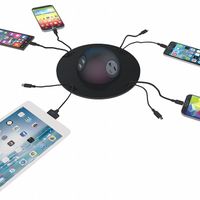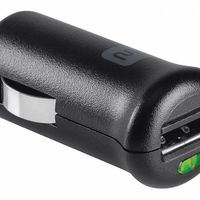Call +(254) 703 030 000 / 751 483 999 / 721 704 777
- Home
- Electronics Batteries
- Batteries Battery Chargers
- Portable Device Chargers
.....Read More
Frequently Asked Questions
What is the best portable charger for my phone?
The best portable charger for your phone depends on your specific needs, but a highly recommended option is the Anker PowerCore 10000. This portable charger is compact, lightweight, and offers a high capacity of 10,000mAh, which can charge most smartphones at least twice. It features high-speed charging technology with PowerIQ and VoltageBoost, ensuring your devices charge quickly and efficiently. The PowerCore 10000 is also known for its durability and reliability, making it a popular choice among users. Additionally, it includes safety features like surge protection and short circuit prevention. If you need more capacity, consider the Anker PowerCore 20000 or the RAVPower 20000mAh, which offer more charges for multiple devices.
How long does it take to charge a portable charger?
The time it takes to charge a portable charger, also known as a power bank, depends on several factors, including its capacity, the input current, and the charging technology used.
1. **Capacity**: Measured in milliampere-hours (mAh), the capacity of a power bank directly affects charging time. A higher capacity power bank, such as 20,000mAh, will take longer to charge than a smaller one, like 5,000mAh.
2. **Input Current**: The input current, measured in amperes (A), is crucial. Most power banks have an input current of 1A, 2A, or higher. A power bank with a 2A input will charge faster than one with a 1A input, assuming the power source can supply the necessary current.
3. **Charging Technology**: Technologies like Quick Charge or Power Delivery can significantly reduce charging times. These technologies allow for higher power transfer rates, provided both the power bank and the charger support them.
4. **Charger Output**: The output of the charger used also impacts charging time. A charger with a higher output (e.g., 5V/2A) will charge a power bank faster than one with a lower output (e.g., 5V/1A).
5. **Cable Quality**: The quality and type of cable used can affect charging speed. A high-quality, short cable with a higher gauge can reduce resistance and improve charging efficiency.
On average, a 10,000mAh power bank with a 2A input might take around 5-6 hours to charge fully using a compatible charger. A larger 20,000mAh power bank could take 10-12 hours under similar conditions. Using fast-charging technologies can reduce these times significantly.
Can I use a portable charger for my laptop?
Yes, you can use a portable charger for your laptop, but there are several factors to consider to ensure compatibility and safety. First, check the power requirements of your laptop, including voltage and wattage, which are usually found on the laptop's power adapter or in the user manual. The portable charger must meet or exceed these requirements to effectively charge your laptop.
Next, ensure that the portable charger has the appropriate output ports. Many modern laptops use USB-C for charging, so a portable charger with a USB-C Power Delivery (PD) port is ideal. If your laptop uses a different type of charging port, you may need an adapter or a portable charger with multiple output options.
Capacity is another important factor. Portable chargers are rated in milliampere-hours (mAh) or watt-hours (Wh). A higher capacity charger will provide more charges or longer usage time. For laptops, a charger with at least 20,000mAh or 60Wh is recommended for effective charging.
Additionally, consider the power output of the portable charger. For laptops, a charger with at least 30W to 65W output is generally required, but this can vary based on your laptop's specifications.
Finally, ensure that the portable charger is from a reputable brand and has safety features like overcharge protection, short-circuit protection, and temperature control to prevent damage to your laptop.
In summary, using a portable charger for your laptop is feasible if the charger is compatible in terms of power requirements, output ports, capacity, and safety features. Always verify these specifications to ensure efficient and safe charging.
How do I know when my portable charger is fully charged?
To determine when your portable charger is fully charged, follow these steps:
1. **LED Indicators**: Most portable chargers come with LED lights that indicate the charging status. Typically, these lights will blink while charging and turn solid or off when fully charged. For example, if there are four LED lights, they might blink sequentially as the charge progresses and all turn solid when the charger is full.
2. **Digital Display**: Some advanced models have a digital display showing the exact percentage of charge. When it reads 100%, the charger is fully charged.
3. **User Manual**: Refer to the user manual for specific instructions related to your model. It will provide details on how the indicators work and what to expect when the charger is fully charged.
4. **Charging Time**: Check the estimated charging time in the manual. If your charger typically takes 4 hours to charge, and it has been plugged in for that duration, it is likely fully charged.
5. **Automatic Shut-off**: Some chargers have an automatic shut-off feature that stops charging once the battery is full. If your charger has this feature, it will stop drawing power from the outlet when fully charged.
6. **App Notification**: If your charger is a smart device connected to an app, you might receive a notification when it is fully charged.
7. **Temperature**: A fully charged battery might feel slightly warm but should not be hot. If it remains cool, it might still be charging.
By using these methods, you can effectively determine when your portable charger is fully charged.
Are portable chargers allowed on airplanes?
Yes, portable chargers, also known as power banks, are allowed on airplanes, but there are specific regulations you must follow. According to the International Air Transport Association (IATA) and most airlines, portable chargers must be carried in carry-on luggage and not in checked baggage. This is due to the lithium-ion batteries they contain, which pose a fire risk if they overheat or are damaged.
The capacity of the power bank is a crucial factor. Most airlines allow power banks with a capacity of up to 100 watt-hours (Wh) without any special permissions. If the capacity is between 100 Wh and 160 Wh, you may need airline approval before bringing it on board. Power banks exceeding 160 Wh are generally prohibited.
To calculate the watt-hour rating if it's not listed, you can use the formula: Wh = (mAh/1000) x V, where mAh is the milliamp-hour rating and V is the voltage.
It's advisable to check with your specific airline for any additional restrictions or requirements, as policies can vary. Some airlines may limit the number of power banks you can carry, typically allowing up to two per passenger.
Ensure that your power bank is in good condition, without any visible damage, and avoid using it during takeoff and landing. It's also recommended to keep it in a protective case to prevent accidental activation or damage.
In summary, while portable chargers are allowed on airplanes, they must be in your carry-on luggage, comply with capacity limits, and adhere to any specific airline policies. Always check the latest guidelines from your airline before traveling.
How many times can a portable charger charge my phone?
To determine how many times a portable charger can charge your phone, you need to consider the capacity of both the portable charger and your phone's battery, typically measured in milliampere-hours (mAh).
1. **Identify Capacities**:
- Find the capacity of your portable charger (e.g., 10,000 mAh).
- Find the capacity of your phone's battery (e.g., 3,000 mAh).
2. **Calculate Theoretical Charges**:
- Divide the portable charger's capacity by your phone's battery capacity.
- Example: 10,000 mAh / 3,000 mAh = 3.33. Theoretically, the charger can fully charge your phone 3.33 times.
3. **Consider Efficiency Loss**:
- Charging involves energy loss due to heat and voltage conversion, typically around 10-20%.
- Adjust for efficiency: 3.33 * 0.8 (assuming 80% efficiency) = 2.664.
4. **Real-World Charges**:
- Realistically, the portable charger can charge your phone approximately 2.5 to 2.6 times.
5. **Additional Factors**:
- **Age and Condition**: Older chargers and batteries may have reduced capacity.
- **Usage During Charging**: Using your phone while charging can reduce the number of full charges.
- **Cable and Connection Quality**: Poor quality can lead to higher energy loss.
By considering these factors, you can estimate how many times your portable charger can charge your phone.
What should I look for when buying a portable charger?
When buying a portable charger, consider the following factors:
1. **Capacity (mAh):** Choose a charger with sufficient capacity to meet your needs. Higher mAh means more charges for your device. For smartphones, 10,000-20,000 mAh is ideal, while tablets may require more.
2. **Output Power (Wattage/Amperage):** Ensure the charger provides adequate output power. Look for at least 2.1A for smartphones and 3A or more for tablets and laptops. Fast charging support (e.g., Quick Charge, Power Delivery) is beneficial for quicker charging.
3. **Input Charging Speed:** A charger with fast input charging (e.g., USB-C PD) will recharge itself quicker, reducing downtime.
4. **Number of Ports:** Consider how many devices you need to charge simultaneously. Multiple USB ports are useful for charging several devices at once.
5. **Port Types:** Ensure compatibility with your devices. USB-A is common, but USB-C is becoming standard for faster charging and data transfer.
6. **Size and Weight:** Balance capacity with portability. Higher capacity chargers are heavier and bulkier, so choose one that fits your travel needs.
7. **Build Quality and Durability:** Look for a robust design with quality materials. Features like shock resistance and water resistance can be beneficial for outdoor use.
8. **Safety Features:** Ensure the charger has safety features like overcharge protection, short circuit protection, and temperature control to protect your devices.
9. **Brand Reputation and Reviews:** Opt for reputable brands with positive reviews to ensure reliability and customer support.
10. **Price and Warranty:** Compare prices for the best value and check for a warranty to protect against defects.
By considering these factors, you can select a portable charger that best suits your needs and ensures reliable performance.


